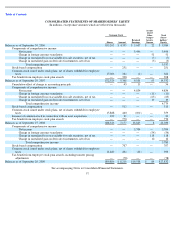Apple 2009 Annual Report Download - page 65
Download and view the complete annual report
Please find page 65 of the 2009 Apple annual report below. You can navigate through the pages in the report by either clicking on the pages listed below, or by using the keyword search tool below to find specific information within the annual report.
Table of Contents
The Company amortizes its intangible assets with definite lives over their estimated useful lives and reviews these assets for impairment. The
Company is currently amortizing its acquired intangible assets with definite lives over periods ranging from one to ten years.
Foreign Currency Translation and Remeasurement
The Company translates the assets and liabilities of its non-
U.S. dollar functional currency subsidiaries into U.S. dollars using exchange rates in
effect at the end of each period. Revenue and expenses for these subsidiaries are translated using rates that approximate those in effect during the
period. Gains and losses from these translations are credited or charged to foreign currency translation included in accumulated other
comprehensive income in shareholders’ equity. The Company’
s subsidiaries that use the U.S. dollar as their functional currency remeasure
monetary assets and liabilities at exchange rates in effect at the end of each period, and inventories, property, and nonmonetary assets and
liabilities at historical rates. Gains and losses from these remeasurements were insignificant and have been included in the Company’
s results of
operations.
Revenue Recognition
Net sales consist primarily of revenue from the sale of hardware, software, digital content and applications, peripherals, and service and support
contracts. For any product within these groups that either is software, or is considered software-
related (e.g., Mac computers, iPhones and iPod
portable digital music and video players), the Company accounts for such products in accordance with the specific industry accounting guidance
for software and software related transactions. The Company applies various revenue-
related GAAP for products that are not software or
software-
related, such as digital content sold on the iTunes Store and certain Mac, iPhone and iPod supplies and accessories, which is described
below.
The Company recognizes revenue when persuasive evidence of an arrangement exists, delivery has occurred, the sales price is fixed or
determinable, and collection is probable. Product is considered delivered to the customer once it has been shipped and title and risk of loss have
been transferred. For most of the Company’
s product sales, these criteria are met at the time the product is shipped. For online sales to
individuals, for some sales to education customers in the U.S., and for certain other sales, the Company defers revenue until the customer
receives the product because the Company legally retains a portion of the risk of loss on these sales during transit. If at the outset of an
arrangement the Company determines the arrangement fee is not, or is presumed not to be, fixed or determinable, revenue is deferred and
subsequently recognized as amounts become due and payable and all other criteria for revenue recognition have been met.
Revenue from service and support contracts is deferred and recognized ratably over the service coverage periods. These contracts typically
include extended phone support, repair services, web-
based support resources, diagnostic tools, and extend the service coverage offered under
the Company’s standard limited warranty.
The Company sells software and peripheral products obtained from other companies. The Company generally establishes its own pricing and
retains related inventory risk, is the primary obligor in sales transactions with its customers, and assumes the credit risk for amounts billed to its
customers. Accordingly, the Company generally recognizes revenue for the sale of products obtained from other companies based on the gross
amount billed.
The Company accounts for multiple element arrangements that consist only of software or software-
related products in accordance with industry
specific accounting guidance for software and software related transactions. If a multiple-
element arrangement includes deliverables that are
neither software nor software-related, the Company applies various revenue-
related GAAP to determine if those deliverables constitute separate
units of accounting from the software or software-
related deliverables. If the Company can separate the deliverables, the Company applies the
industry specific accounting guidance to the software and software-related deliverables and applies other appropriate guidance to the non-
software related deliverables. Revenue on arrangements that include multiple elements such as hardware, software and services is allocated to
each element based on the
62
























